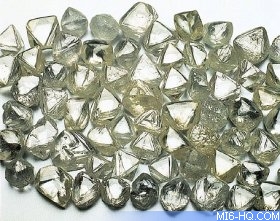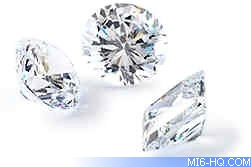 |
| |
The plot of "Die Another Day" starts and
ends with Bond handling diamonds, now MI6 details
the backstory on the conflict stones...
|
|
"Die Another Day" Backstory - Conflict
Diamonds
10th July 2003
Planting an agent in the guise of a diamond smuggling weapons
trader seemed a straight forward assignment as far as MI6 was
concerned, until James Bond "killed" the target - Colonel
Moon. Diamonds are the global currency for illegal trades, especially
for the kind of weapons Moon was trading. Bond impersonated Mr
Van Beert during the deal, no doubt a tongue in cheek reference
to De Beers - the world's biggest diamond trader.
|
The backstory of "Die Another Day" utilises the
current conflict diamond crisis in Africa, where they are
are smuggled and illicitly sold in order to fund rebel groups
engaged in civil war and human rights abuses in the countries
such as Sierra Leone, Angola and the Democratic Republic
of Congo. In Sierra Leone - the country identified in the
film - rebel forces that control most of the country's diamond
mines use the income from conflict diamonds to buy weapons
and sustain their army - an army infamous for a long list
of atrocities: rape, the conscription of child soldiers,
and the systematic mutilation of thousands.
|
|

Above: Uncut diamonds |
Raoul: "Ah yes, from the Graves Corporation
in Iceland. That's his laser signature. A man called Gustav Graves
discovered diamonds there a year or so ago."
Bond: "Yet they're identical to conflict diamonds. What an
amazing coincidence."
After Colonel Moon completes his transformation into Gustav Graves
(whilst Bond was held captive in North Korea), he "discovers"
diamonds in Iceland. A seemingly endless supply keeps the villain
stocked with everything he needs, including the space satellite
"Icarus", which uses the stones to reflect sunlight.
Of course, the mine is fake and it is simply a front for Colonel
Moon to launder his diamonds through a reputable business and
reap the rewards.
Bond: "I think it's a front for laundering
African conflict diamonds."
M: "We need to tread carefully. Graves is politically connected."
Back in the real world, the diamond industry says conflict diamonds
account for less than four percent of the world’s $7 billion
trade in uncut stones; human rights advocates estimate the figure
to be closer to 25%.

Above: Diamonds are forever. |
|
The film shows Gustav Graves marking each stone
with his distinctive "GG" logo by a process using
highly accurate laser etching. This fictional identification
system may soon become reality in the fight to clean up the
diamond trade. However, the real-world technology is not yet
available for marking individual diamonds; and the industry
argues that it will never be practical or affordable to mark
the 860m stones polished each year, despite lobbying from
human rights organisations. |
But would the real SIS ("MI6" in the films) investigate
a case of conflict diamond trading? Yes - according to Paul Higdon,
director of criminal intelligence at Interpol. He said agencies
had "not had a lot of intelligence" in the past, but
that was fast changing.
"I have seen some of the biggest targets, the untouchables,
fall," said Higdon. "Once we find Mr X is the big man
in terms of arms deals and they are illegal we can start targeting
some efforts in trying to prosecute these people."
In May of 2000, government officials, diamond-industry leaders,
and NGOs from around the globe met in Kimberley, South Africa
to develop a global "conflict-free"certification system
for diamonds. Negotiations concluded in March 2002 and the agreement
- called the Kimberley Process - was implemented in January 2003,
just a couple of months after "Die Another Day" premiered.